Wired
A Jolt of Light: CableLabs Holds First 200G P2P Coherent Optics Interop

Anyone remember the jingle for Jolt® Cola? All the sugar and twice the caffeine! Perhaps the phrase dates me, but I still hear it in my head—although I now have new words to set to it:
All the distance and twice the capacity!
OK, maybe it doesn’t have quite the same ring to it. But it’s still exciting because that’s what was demonstrated last month in our labs for Point-to-Point Coherent Optics (P2PCO). We confirmed that devices compliant with CableLabs’ P2PCO PHYv2.0 specification can transmit over roughly the same distance as devices compliant with our P2PCO PHYv1.0 spec, and at double the operating capacity: 200 Gbps vs. 100 Gbps per wavelength. Even more importantly, this result was achieved while also demonstrating multi-vendor interoperability, a key component of achieving scale and promoting competition in the marketplace. All together, these developments allow operators to cost-effectively expand the capacity of the fiber that’s already deployed in their access networks.
We validated interoperability and performance at one of CableLabs’ Interop events, as we’ve done in the past for other technologies, including coherent optics. These events provide an opportunity for multiple manufacturers to get together on neutral ground and test how their products work with each other. In fact, we held Interop events for devices compliant with our P2PCO PHYv1.0 specification, which defines operation at 100 Gbps per wavelength, back in December 2018 and June 2019.
So why the long delay between those tests and June’s Interop? While support for 200 Gbps per wavelength does require new digital signal processor (DSP) silicon, we had originally planned to hold our first 200G event in late 2020. And we all know what happened in 2020—and 2021!
Representing the Majority of the Coherent Optics Industry
Fortunately, the manufacturers didn’t waste that additional time. Instead, they used it to further develop their products. As a result, this was possibly one of the most boring Interop events I’ve ever been a part of—because things simply worked! I won’t claim that troubleshooting wasn’t necessary (it virtually always is), but the manufacturers’ ability to quickly get their devices working with each other was truly impressive.
The Interop participants were:
The number of participants might not be high, but what’s important is that the participants include DSP silicon from multiple manufacturers that represent the majority of the coherent optics industry. Demonstrating interoperability among so many different coherent DSPs bodes incredibly well for operators because it allows them to avoid being locked into single-vendor solutions, which promotes scale and competition.
Another Piece of the 10G Puzzle
As operators move toward the deployment of 10G-capable networks, guaranteeing sufficient capacity across the entire network will be critical for ensuring great customer experiences. P2P coherent optics represents a cost-effective means of increasing the capacity of the existing network. This enables the deployment of new, higher-speed connections into customer homes via technologies like DOCSIS 4.0 at lower costs and opens up new service opportunities, such as support for wireless.
When cable operators deploy coherent termination devices (CTDs) in their network, they may choose to initially deploy them using 100G transceivers. Then, when it’s needed, they can simply replace a pair of transceiver modules with this 200G technology to double the capacity of their network links without relocating or adding other equipment. This allows operators to scale their network capacity quickly and easily based on demand, while spending only what’s needed when it’s needed.
We believe that will serve as an incredibly powerful tool in their toolset, putting in place one more piece of the puzzle that will ultimately power a 10G future.

Wired
Release of New FMA Specs Opens Door for Interop Events
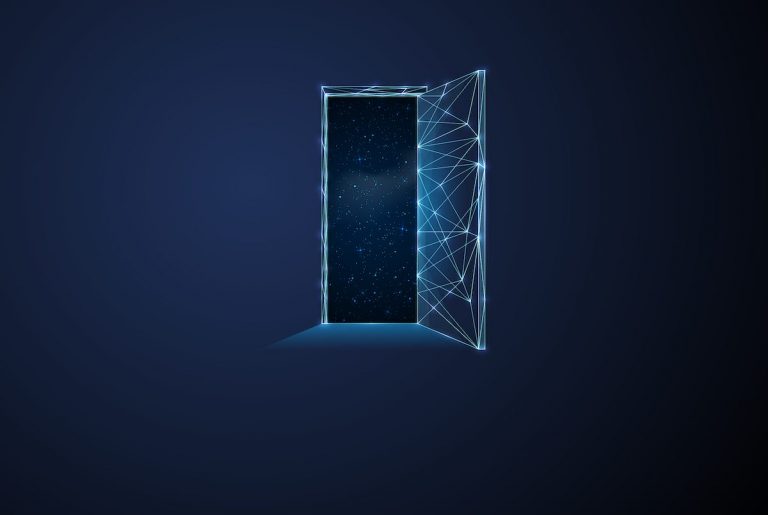
We are pleased to announce today’s issuance of new versions of the Flexible MAC Architecture (FMA) System and MAC Manager Interface (MMI) specifications. This release denotes the completion of phase one for the FMA specifications and opens the doors for beginning FMA interoperability events. Speaking of such events, we are also pleased to inform you that we have completed our first formal FMA interop.
Flexible MAC Architecture Industry Milestones
Both are important milestones for the cable industry. The completion of the first phase of the FMA project is the accumulation of specification work through the pandemic and defines the Remote MACPHY (R-MACPHY) technology. As a part of the larger Distributed CCAP Architecture (DCA) program, FMA is defining the complete disaggregation of a CCAP’s functionality. This includes separating the control and data planes and providing standard interfaces between OSS/NMS/Orchestration and the FMA management and control planes, as well as a standard interface abstraction layer to cable access equipment. All of which allows for vendor independence and equipment interoperability. While the Remote PHY specifications was the first step in CCAP disaggregation, by moving the PHY layer out of the big iron CCAP hardware, FMA is the next and final step of a fully disaggregated DOCSIS access network.
The DCA specifications are a cornerstone of the 10G Platform that will allow DOCSIS 4.0 technologies to support multi-gigabit symmetric speeds. Both DCA technologies have recently reached significant achievements. For FMA, Charter and Vecima demonstrated 8.5 Gbps downstream and 6 Gbps upstream speeds with their FMA implementation. Similarly, For R-PHY Comcast was able to demonstrate 4 Gbps symmetrical speeds with their DOOCSIS 4.0 implementation. Both are significant for the cable industry and a true realization of the technology being specified at CableLabs.
While this release wasn’t the first release of the FMA specification library, this third version of the issued specifications represent a maturity that allows the industry to begin building and testing interoperable products. As such, the week of January 10th was the realization of the first formal interoperability event for the FMA technology. The event had a total of 10 companies involved with five participating vendor companies and five cable operator observers. This was a tremendous turnout for the initial interoperability event. A significant set of accomplishments were hit at this first event which shows the maturity of products and the specification.
Upcoming FMA Activities
Moving forward, there are several activities within the FMA project on the foreseeable horizon. As previously mentioned, there are ongoing quarterly interoperability events in 2022 that allow vendors to test their products with other vendor products in a neutral environment. We have the ability to increase this cadence as needed. CableLabs also has the ability to support interop activities 24 hours per day, seven days a week with remote connections for the interoperability lab for those products that are installed in the lab. This is a very important activity for the industry that ultimately leads to operator deployment of the technology. CableLabs is also producing an FMA webinar on February 16th where we will share and discuss the “state of FMA,” including long-term FMA objectives, and future goals of the interoperability events.
If you would like to participate in the FMA working group activities, please make your request via workinggroups@cablelabs.com.

Wired
Finishing the P2P Coherent Optics Puzzle

This past June, CableLabs publicly released the first issued version of the Coherent Termination Device (CTD) Requirements Specification. The same month, the Institute of Electrical and Electronics Engineers (IEEE) Standards Association (SA) approved amendment 802.3ct-2021, which defines 100G Ethernet using coherent optics. Combined with previous point-to-point (P2P) coherent optics specifications released by CableLabs, these two events represent two of the final pieces of the puzzle for enabling low cost, interoperable, coherent optics solutions for cable operators.
Coherent Termination Device
CableLabs has developed a series of specifications to enable the development of interoperable transceivers using P2P coherent optics that are optimized for cable access networks, including operation at 100G and 200G per wavelength. This work was highly successful; there are transceivers compliant with the CableLabs PHYv1.0 specification (100G operation) as demonstrated at interop events held pre-pandemic, and transceivers compliant with the PHYv2.0 specification are in development. Additionally, routers and switches that those transceivers can be plugged into also exist, as seen at the demonstration CableLabs hosted at SCTE Expo 2019 in New Orleans.
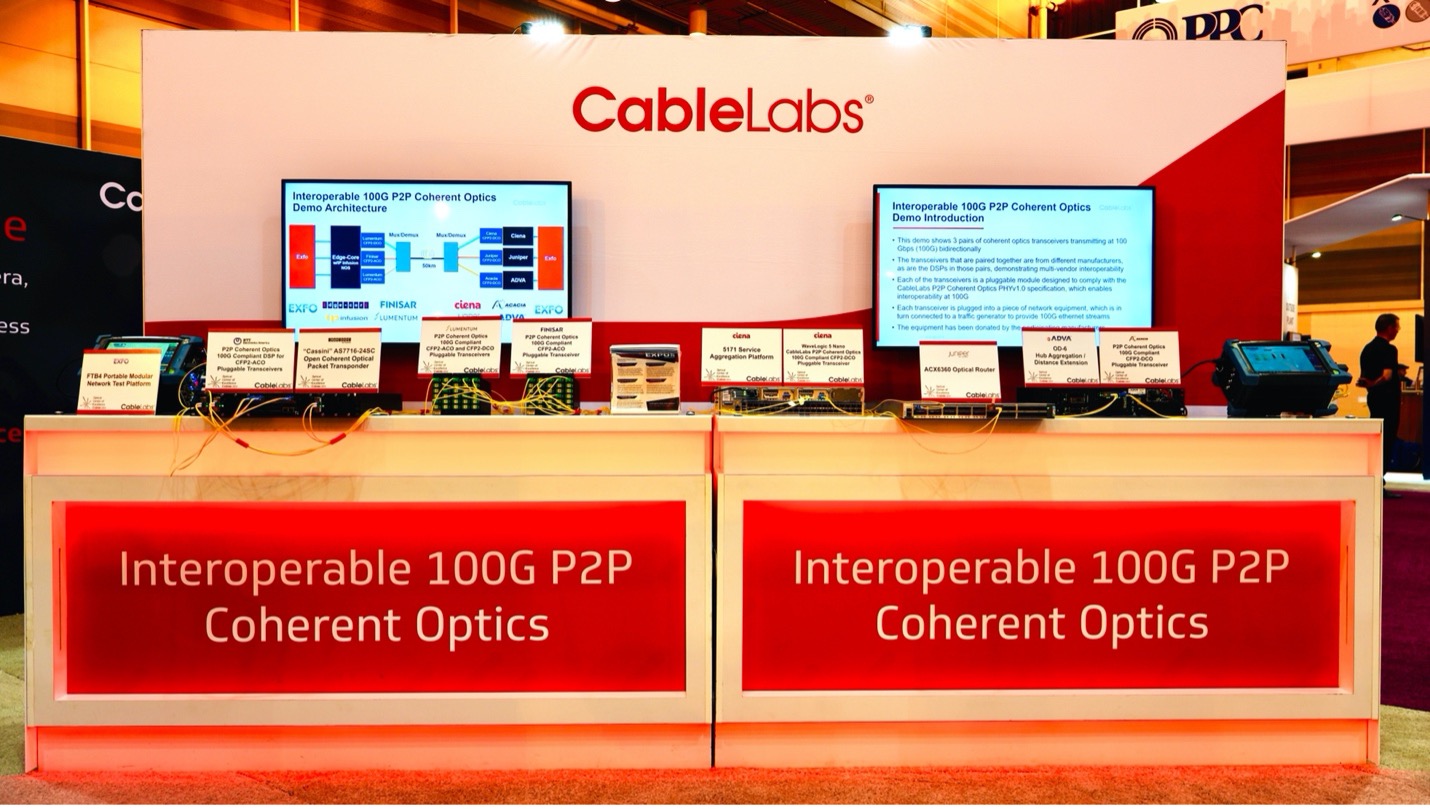
However, there’s one key thing that’s unique to a cable access network deployment as compared to most other P2P coherent optics deployments to date: one end of the link sits outdoors. And while some existing solutions could operate in the temperature ranges required for an outdoor environment, they had to be installed in a street cabinet vs. the type of weatherproof enclosure (typically a clamshell box) that is typically used by many cable operators.
That device is what we refer to as a CTD that resides in an Aggregation Node, as shown in the figure below. The CTD for an Aggregation Node was a missing puzzle piece!
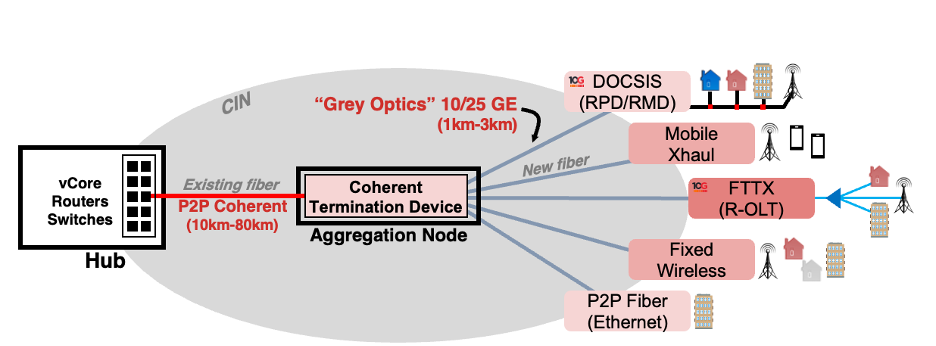
In order to address this issue, CableLabs worked with our members to develop the CTD Requirements Specification. This specification contains a set of requirements that are common across multiple different cable operators, representing a broad consensus on the definition for several critical aspects of a CTD. That in turn provides some assurance to manufacturers that if they build a CTD that meets those requirements they should find a broad market for the device.
Some key highlights of those requirements include:
- A minimum of 2 line-side ports per CTD that support pluggable coherent optics transceiver modules
- A minimum of 12 (and recommendation for 16) client-side ports per CTD that support 10G and/or 25 transceiver modules
- Layer 2 (switching) and/or Layer 3 (routing) support
- Guidance on power sizing and efficiency
- Enclosures that meet IP66 requirements
- Operation in external ambient temperatures from -40 to +60 degrees C
IEEE 802.3ct-2021
One of the keys for enabling the use of P2P coherent optics in cable operator networks reducing cost as much as possible, which is why that has been a focus at CableLabs. Both of the P2P Coherent Optics PHY specifications were written with cost in mind by incorporating inputs from suppliers, identifying optimizations for cable networks that will enable reduced cost devices, and promoting interoperability (leading to scale and competition).
Another way to drive scale is to encourage adoption by other groups and industries. For that reason, CableLabs decided to support and participate in an effort within the IEEE 802.3 Ethernet Working Group to define a standard for specifying 100G operation per wavelength using coherent optics. In particular, CableLabs wanted to ensure that manufacturers would be able to develop devices that complied not only with our CableLabs specifications, but also with the new IEEE standard.
A review of the new 802.3ct amendment suggests that goal has been achieved, and as a result, it should be possible for manufacturers to build a single device that complies with requirements from CableLabs, IEEE, ITU and OpenROADM, meaning there is a huge market for coherent optics equipment that manufacturers can take advantage of without having to build multiple different devices.
Puzzle Pieces Coming Together
With these two puzzle pieces now complete, the picture and opportunity for using P2P coherent optics in cable operator networks is really coming together. Compliant transceiver modules and equipment suitable for indoor facilities (such as hubs and headends) are already available, and CTDs are expected later this year or early next year, enabling deployments in the not-too-distant future. Better still, it’s becoming clear that there are architectures and applications that can leverage CTDs beyond just cable networks — such as for supporting mobile network deployments — meaning there’s likely a broad, nascent market just waiting to take off. Keep an eye on this space – things are just getting started.

Wired
Everything You Want to Know About Coherent Optics for Access Networks (But Were Afraid to Ask)

The cable industry has been well served by its extensive fiber deployment that took place during the initial hybrid fiber-coax (HFC) buildout. Even though cable operators have answered capacity demand through fiber node-splits in specific high demand scenarios, only recently have operators embarked on deeper-fiber roll-out strategies as part of a comprehensive long-term evolution plan.
The exponential growth in demand for capacity prompted CableLabs to explore how to best use cable’s optical infrastructure resources. This exploration led to research activities for the introduction of coherent optics in the access environment. We’re delighted to announce the publication of the book “Coherent Optics for Access Networks” by CRC Press (Taylor & Francis Group), highlighting many of CableLabs’ research activities.
The book discusses how coherent optics in the access network is re-engineered to simultaneously achieve lower complexity and higher performance afforded by the generous link margins characteristic in shorter links. This instantiation of coherent optics is not only suitable for cable access but also for telco and cellular fiber access networks.
Recent developments in the field of coherent optics for access network applications that will support point-to-point (P2P) aggregation use cases and point-to-multipoint (P2MP) fiber to the user’s passive optical network are examined. Optical industry trends as well as the conventional intensity modulation and direct detection (IM-DD) systems and newly developed advanced direct-detection architectures leveraging four-level pulse amplitude modulation format, Stokes receivers and Kramers–Krönig receivers are also presented.
This book focuses on how to adapt coherent optics technology to the access environment in ways that address major cost challenges, such as simplified transceiver design and photonic integration. An example, is the introduction of full-duplex coherent optics, which enables simultaneous bidirectional transmission on the same wavelength thereby doubling fiber’s capacity. Full-duplex coherent optics is an approach that is feasible to implement in the shorter-link-length access environment.
The book provides economical modeling for aggregation uses cases in comparison with traditional 10G IM-DD DWDM based solutions. Implementation requirements, unique to the access environment, are also provided when introducing coherent optics into access scenarios, including coexistence with existing services and security challenges. Progress on recent-specification development activities is reviewed for many industry organizations that focus on short-distance coherent optics interoperability.
In writing this book, the authors have benefitted from the numerous interactions with experts within the optical telecommunication components and systems community, in particular with the vendor and operator members that contributed to CableLabs’ point-to-point coherent optics specification. This book represents a first look of technological advances in coherent optics, in the interest of future proofing of our access networks.
Favorable coherent component cost-reduction trends are expected to continue, technological advancements will enable higher performance and simpler implementations will make coherent technology more pervasive in the access network so that exponential growth in capacity is achieved. Given the headway gained in specification generation bodies and the development progress of optical component and transceiver manufacturers focusing on shorter link distances, a future with coherent optics in the access network is upon us.

Wired
Cable Network Reliability: ProOps Platform for PNM and More!

Cable network reliability has many important dimensions, but operators are all too familiar with the significant cost of maintenance and repair, and some with the advantages of Proactive Network Maintenance (PNM). But not everyone has taken full advantage of PNM. Let’s have a look at some of the reasons for that, and what CableLabs is doing to address those needs as part of its PNM project.
The Proactive Operations Problem
CableLabs has been informally assessing the reasons why more operators don’t take advantage of the proactive gift that DOCSIS® provides: the ability to use PNM data to find problems in the network before they become impactful and costly.
It takes a lot of work to implement solid PNM solutions that keep working. A key task in operations is to make decisions based on data. That takes expertise and time. Not every operator or vendor has an expert army in place to analyze all the available operations data to find proactive maintenance work worth doing. Machine learning is anticipated to help, but it will require a lot of work to apply those techniques successfully to an operations task like PNM, and even more to develop the needed controls. Likewise, not every operator or vendor has a statistical analysis or IT army in place to build enterprise tools to automate the process of turning data into action.
Some operators need to start small with testing PNM concepts to find a solution that fits their needs. That means many operators must experiment and learn first. But that requires basic, general tools in hand before experimentation can begin.
A ProOps Platform for Everyone
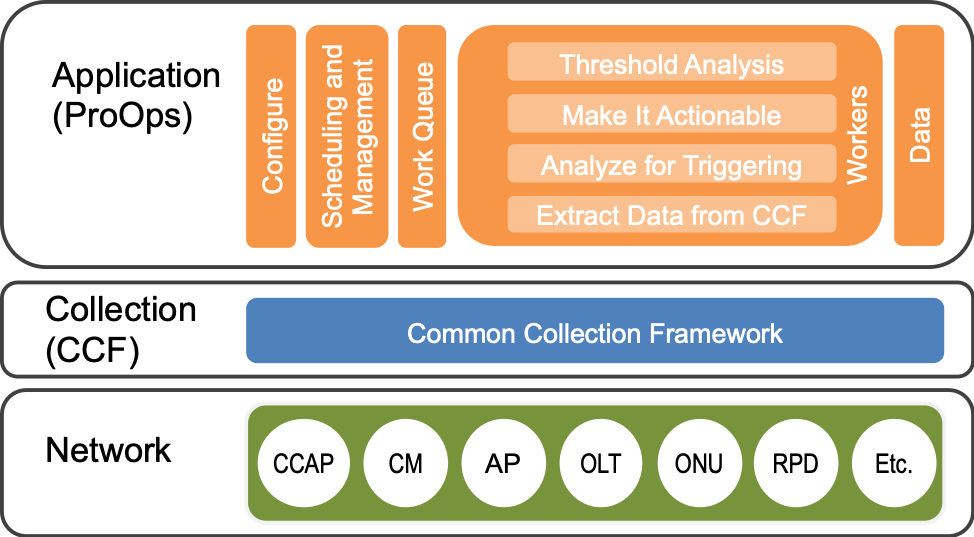
Figure 1. ProOps with its elements and workers in four layers, built on CCF, on top of the network.
CableLabs created a generalized process for translating data into operations actions and applied it to PNM. Then we built the Proactive Operations (ProOps) platform to enable this process, thus making it easy for everyone to try, develop, deploy and make full use of PNM.
ProOps translates network data into action through a framework that is not strictly enforced but is enabled and supported to better ensure effective proactive maintenance.
The steps we identify for turning network data into action are briefly as follows, moving up from the network, through data collection, and through the worker layers of ProOps in Figure 1.
- Extract Data from the Common Collection Framework (CCF)—ProOps uses CCF to extract the data it needs from the network, then applies basic analysis to translate the data into useful information.
- Analyze for Triggering—Next, the results are analyzed further to determine whether they are interesting or not; interesting results are “triggered” for deeper scrutiny. The data are looked at over time and across data sources to orient the information into context.
- Make It Actionable—Once we find the most interesting network elements to watch, we group network elements into network tasks and provide a measure of importance for the identified work.
Threshold Analysis—The best work opportunities get picked to become proactive work packages, which can be selected based on impact to customers, likelihood of becoming an emergency, and so on.
You ShOODA Get ProOps!
The steps we outline for turning network data into action—or in this case pro-action—align nicely with the well-known strategy of observe, orient, decide, act (OODA). This OODA loop, or OODA process, was created by U.S. Air Force Colonel John Boyd for combat operations. The operations of combating network failure aren’t much different! If you work as a cable operator, then you know.
ProOps is available upon request to any operator member or vendor of the CableLabs community. CableLabs supports users by helping them to deploy ProOps with an example application that shows how to configure it to a specific operator or use case, and we will help our members develop solutions in it, too. Just contact Jason Rupe to get your copy.
Our goal is to help operators provide highly reliable service, and efficient, effective operations is one proven way to do that. ProOps is the latest tool to combat network failures.

Wired
OFC: A Third of a Mile of Next-Gen Optics

0.0000026 seconds.
For the more technically inclined, that’s 2.6 microseconds. Which is how long it would take light to travel a third of a mile through fiber optic cable. It was also the length of the show floor at OFC: The Optical Networking and Communications Conference and Exhibition, held in March in San Diego, California.
Of course, it took me considerably longer – 115,384,615 times longer, or about 5 minutes – to walk that same distance at the show. And that’s assuming I maintained a fast pace and avoided stopping for the entire distance – a feat that proved essentially impossible, given the amazing assortment of next-generation optical technology on display, as well as a large number of familiar faces around me!
CableLabs Represented
The show floor hosted 683 exhibitors – too many to take in over such a short time. Among them were many of the companies that have been involved in the CableLabs P2P Coherent Optics effort, helping to blaze the trail for the use of coherent optics technology in the cable access network, in turn enabling our 10G vision. In those booths, many were showcasing products that support 100G speeds based on our PHYv1.0 specification, as well as their roadmap and plans for devices supporting 200G speeds based on our PHYv2.0 specification. Roaming the show floor, checking out exhibited products or enjoying key sessions, I kept running into many of the direct participants in our efforts, despite the fact that 15,400 people were in attendance.
It didn’t seem that I could go very far without encountering someone from a significant CableLabs contingent or one of our members, reflecting the importance of next-generation optics to the cable industry, as well as CableLabs’ strong commitment to developing new optical technologies. Our Optical Center of Excellence has been at the forefront of developing innovative approaches for applying optical technology to cable networks, such as Full Duplex Coherent Optics.
CableLabs on Display
Although CableLabs wasn’t an official exhibitor, beyond having a contingent of people present, CableLabs and cable definitely had a presence at this year’s OFC. The importance of the cable industry was mentioned during a keynote speech; Curtis Knittle participated on a panel on “Action in the Access Network” as a part of the OIDA Executive Forum, and one of our interns presented a poster as part of a collaboration with CableLabs’ Bernardo Huberman and Lin Cheng.
Another presentation from our own Mu Xu also illustrated how CableLabs is pushing the boundaries of optical technology. This presentation – titled “Multi-Stage Machine Learning Enhanced DSP for DP-64QAM Coherent Optical Transmission” and co-authored by other CableLabs thought leaders including Junwen Zhang, Haipeng Zhang, Jing Wang, Lin Cheng, Zhensheng Jia, Alberto Campos, and Curtis Knittle – was particularly noteworthy because it brought together multiple areas of next-generation technology and research going on at CableLabs.
This was my first year attending OFC, and I feel like I barely scratched the surface of what was there. More than anything else, I came away impressed by the impact that the CableLabs team is making on the optical industry, one that will be critical for enabling our 10G future. I’m greatly looking forward to next year.

Wired
Proactive Network Maintenance (PNM): Cable Modem Validation Application(s)

Sometimes, two apps are better than one. We now have two versions of the Cable Modem Validation Application (CMVA) available for download and use: a new lab automation version, and a data exploration version.
Thing One and Thing Two
Lab automation and certification have unique requirements, but investigation and invention require flexibility. Because the CMVA found value as a cable modem (CM) data plotter and browser on top of its original purpose as a lab testing tool, we decided there should be two versions—one focused on each use case.
Sometimes You Feel Like a DUT
The newest, most complex version of CMVA is built specifically for CM Cert-Lab testing and includes several new features and automations:
- Improved efficiency for CMVA on certification testing: CMVA now discovers OFDM/OFDMA-based topology information from the CMTS and loads all related channel configuration information automatically for testing. CMVA also synchronizes PNM SNMP SET command parameters with XCCF for better efficiency and greater control.
- Automated discovery of the active DOCSIS® 3.1 CM list: Users can easily select CMs with their test configurations automatically filled to start tests with a few clicks.
- CMVA now runs multiple PNM tests sequentially on multiple CMs in parallel with simple clicks on a single user login: The latest test reports are directly served from the CM table. Different users are handled in parallel, as previously.
- CMVA now embeds detailed testing logs into the HTML test report: The log file can be downloaded from the HTML test report. The HTML test report is portable.
- CMVA now keeps copies of raw PNM test files together with the test reports for vendor debugging references: When downloading the test reports, CMVA packages the test logs in raw text, and forms the portable HTML test report into a single archive.
- All the Acceptance Test Plan (ATP) calculation activities are placed in the log file for vendor debugging references.
- We added a function for resetting CMs remotely with one click: This is important for testing and useful for other purposes.
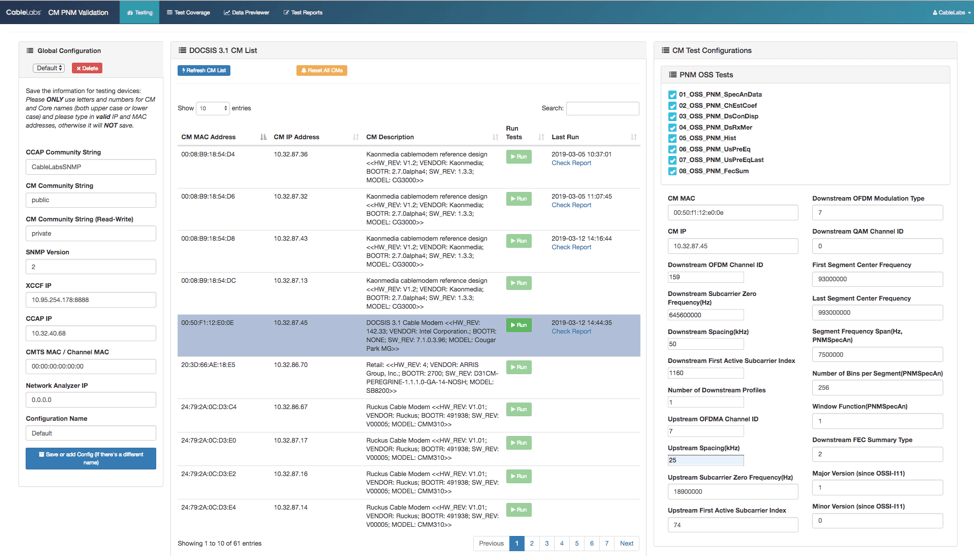
Figure 1: New layout for test and configuration management
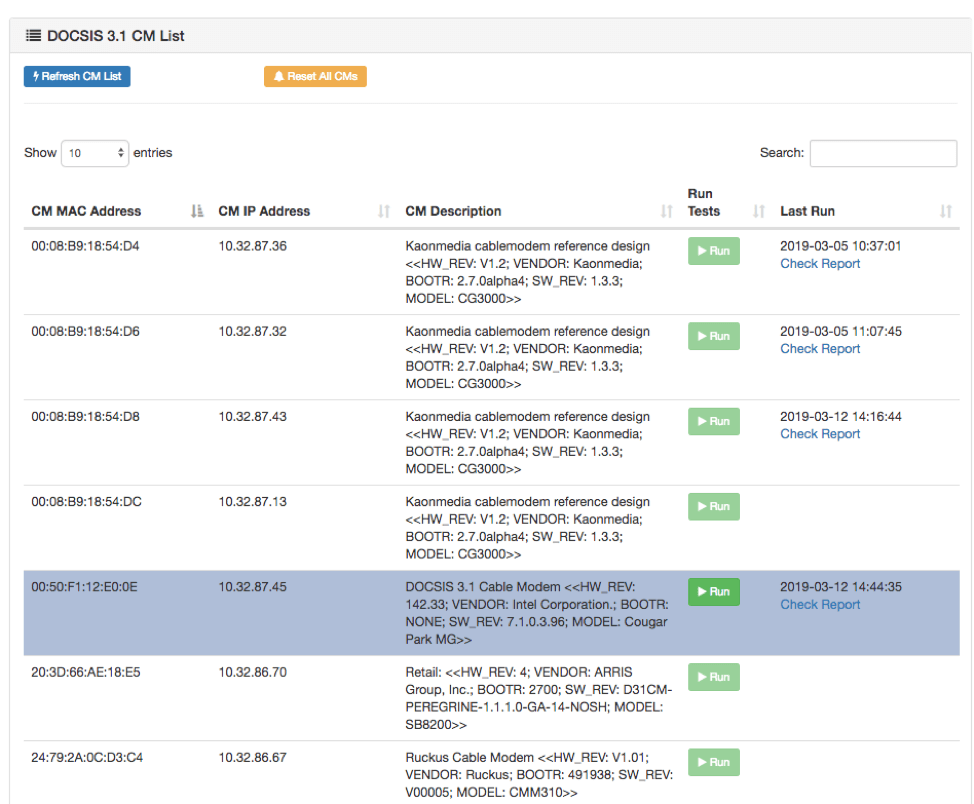
Figure 2: Select CM directly from the table to start tests; the latest reports are linked directly in the table for convenience
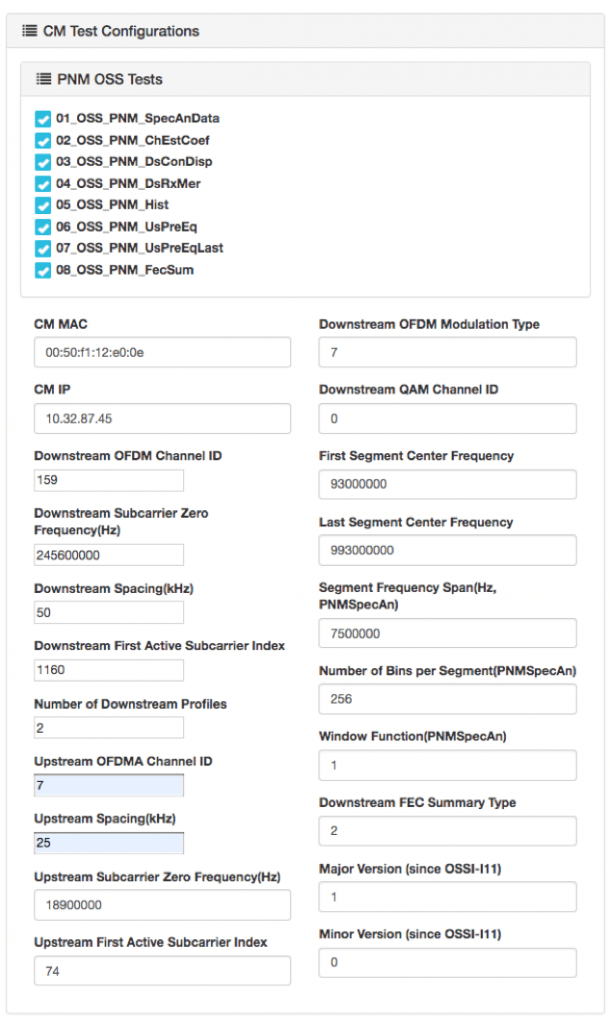
Figure 3: The test procedures ran last time are tracked, and the configurations are automatically filled
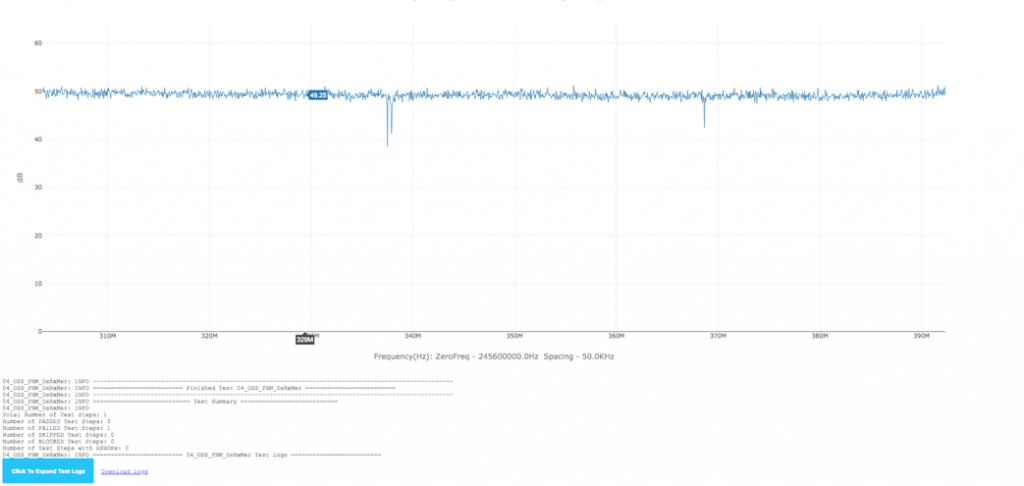
Figure 4: Detailed test logs are embedded directly into the portable HTML test report and can be downloaded as pure text log
All these new features are important for test automation, but some of them are useful for other needs. Go nuts! But if you simply want the basic capabilities that CMVA always provided, you can still get that version.
Sometimes You Don’t
Sometimes you just want a simple way to poll a set of modems and see what you can get. The previous version is a bit simpler, but it still has the validation capabilities if you need them. So, it might be the version that can address most, if not all, of your needs. We use it for many purposes but mainly as a testing and development tool. Here are some specific use cases we’ve encountered:
- Testing ideas in the lab: The PNM Working Group InGeNeOS conducted lab testing, as reported on before, and we used CMVA to grab data from CMs under test.
- Developing applications: As we work to develop our first large-scale PNM base application, inside our prototype PNM Application Environment, we use CMVA to develop theories about how the data can be processed for automated processing.
- Building reports and documenting: So often, we need to capture what certain impairments look like, or obtain a good visualization of a PNM measurement, and CMVA makes that handy.
- Investigating issues: With CMVA, it’s a simple matter to collect data from a pool of CMs and compare the results. This helps us investigate many issues, including changes in firmware versions, CM responsiveness, and other potential issues with plant configuration, software changes and so on.
- Combined Common Collection Framework (XCCF) development and testing: As we develop new capabilities with our XCCF, we can use CMVA to validate its functionality.
If you are a user of CMVA, let us know how you have used it!
Two Can Play at That Game
Although the more complicated testing tool can be used for all these use cases and many more, some users don’t need the automation, overhead and many controls required for automated testing. When you contact us to get an updated version of CMVA, please let us know what you would like to use it for. That way, we can offer you the right version.

Wired
Forward Error Correction (FEC): A Primer on the Essential Element for Optical Transmission Interoperability

Forward error correction (FEC) has been a powerful tool in the cable industry for many years. In fact, perhaps the single biggest performance improvement in the DOCSIS 3.1 specifications was achieved by changing the FEC being used in previous versions – Reed-Soloman (RS) – to a new coding scheme with improved performance: low-density parity check (LDPC). Similarly, FEC has also become an indispensable element for high-speed optical transmission systems, especially in current coherent optical transmission age.
FEC is an effective digital signal processing method that improves the bit error rate of communication links by adding redundant information (parity bits) to the data at the transmitter side so that the receiver side then uses the redundant information to detect and correct errors that may have been introduced in the transmission link. As the following figure shows, the signal encoding that takes place at the transmitter has to be properly decoded by the receiver in order to extract the original signal information. Precise definition and implementation of the encoding rules are required to avoid misinterpretation of the information by the receiver decoding the signal. Successful interoperability will only take place when both the transmitter and receiver follow and implement the same encoding and decoding rules.

As you can see, FEC is the essential element that needs to be defined to enable the development of interoperable transceivers using optical technology over point-to-point links. The industry trends are currently moving toward removing proprietary aspects and becoming interoperable when the operators advocate more open and disaggregated transport in high-volume short-reach applications.
When considering which FEC to choose for a new specification, you need to consider some key metrics, including the following:
- Coding overhead rate— The ratio of the number of redundant bits to information bits
- Net coding gain (NCG)— The improvement of received optical sensitivity with and without using FEC associated with increasing bit rate
- Pre-FEC BER threshold— A predefined threshold for error-free post-FEC transmission determined by NCG
Other considerations include hardware complexity, latency, and power consumption.
One major decision point for FEC coding and decoding is between Hard-Decision FEC (HD-FEC) and Soft-Decision FEC (SD-FEC). HD-FEC performs decisions whether 1s or 0s have occurred based on exact thresholds, whereas SD-FEC makes decisions based on probabilities that a 1 or 0 has occurred. SD-FEC can provide higher NCG to get closer to the ideal Shannon limit with the sacrifice of higher complexity and more power consumption.
The first-generation FEC code, standardized for optical communication, is RS code. RS is used for long-haul optical transmission as defined by ITU-T G.709 and G.975 recommendations. In this RS implementation, each codeword contains 255 code word bytes, of which 239 bytes are data and 16 bytes are parity, usually expressed as RS (255,239) with the name of Generic FEC (GFEC). Several FEC coding schemes were recommended in ITU-T G. 975.1 for high bit-rate dense wavelength division multiplexing (DWDM) submarine systems in the second-generation of FEC codes. The common mechanism for increased NCG was the use of concatenated coding schemes with iterative hard-decision decoding. The most commonly-implemented example is the Enhanced FEC (EFEC) from G.975.1 Clause I.4 for 10G and 40G optical interfaces.
At the 100 Gbps data rate, CableLabs has adopted Hard-Decision (HD) Staircase FEC, defined in ITU-T G.709.2 and included in the CableLabs P2P Coherent Optics Physical Layer v1.0 (PHYv1.0) Specification. This Staircase FEC, also known as high-gain FEC (HG-FEC), is the first coherent FEC that provides an NCG of 9.38 dB with the pre-FEC BER of 4.5E-3. The 100G line-side interoperability has been verified in the very first CableLabs’ Point-to-Point (P2P) Coherent Optics Interoperability Event.
At the 200 Gbps data rate, openFEC (oFEC) was selected in CableLabs most-recent release of P2P Coherent Optics PHYv2.0 Specification. The oFEC provides an NCG of 11.1 dB for Quadrature Phase-Shift Keying (QPSK) with pre-FEC BER of 2E-2 and 11.6 dB for 16QAM format after 3 soft-decision iterations to cover multiple use cases. This oFEC was also standardized by Open ROADM targeting metro applications.
Although CableLabs has not specified 400G coherent optical transport, the Optical Interworking Forum (OIF) has adopted a 400G concatenated FEC (cFEC) with soft-decision inner Hamming code and hard-decision outer Staircase code in its 400G ZR standard; this same FEC has been selected as a baseline proposal in the IEEE 802.3ct Task Force. This 400G implementation agreement (IA) provides an NCG of 10.8 dB and pre-FEC BER of 1.22E-2 for coherent dual-polarized 16QAM modulation format specially for the Data Center Interconnection (DCI).
The following table summarizes performance metrics for standardized FEC in optical fiber transmission systems.

CableLabs is the first specification organization to demonstrate 100G coherent optics interoperability with a significant level of participants. Please register for our next coherent optics interoperability testing.

Wired
The P2P Coherent Optics Specification of the Future, Available Today

Today, CableLabs is announcing another addition to our family of Point-to-Point Coherent Optics specifications: The Physical Layer 2.0 (PHYv2.0) specification. This new specification defines interoperable point-to-point (P2P) coherent optics links running at 200 Gbps (200G) on a single wavelength.
Just 9 months ago, in July of 2018, CableLabs announced the release of the P2P Coherent Optics Physical Layer 1.0 (PHYv1.0) specification, which defines operation at 100 Gbps (100G) on a single wavelength. The PHYv1.0 specification is designed to support rapid product development, ensuring the availability of interoperable products quickly. That quick availability was born through the interoperability event we held this past December, in which 9 different suppliers participated and demonstrated 100G interoperability.
In other words, the specification of the Now
The PHYv2.0 specification, on the other hand, is designed to leverage an emerging new generation of silicon and the resulting devices, which are anticipated to arrive by 2020. Those new devices will double the capacity of the cable access network, consume less power, and lower the cost per bit delivered. All on the network that already exists today.
This is the specification of the Future: A future that’s coming very quickly
Further, this new specification is a key part of another future that’s coming soon: the 10G future recently unveiled by the cable industry. P2P coherent optics running at 100G – and now 200G – allows cable operators to leverage the fiber they’ve already deployed to support that future vision as cost effectively as possible by greatly increasing the capacity of their existing hybrid fiber coax (HFC) networks. That, in turn, enables the enhanced services and experiences envisioned as a part of the 10G future.
Whether the connection to the customer is wired or wireless, at some point all of those network connections need to be aggregated together. The CableLabs suite of coherent optics specifications – now highlighted by the PHYv2.0 specification, defining interoperable 200G operation – will serve as a critical piece of enabling our interconnected future. Fill out the form below for more information.
Wired
Preparations for Full Duplex DOCSIS® Technology are Marching Along

Built on the successful completion of CableLabs’ DOCSIS 3.1 specification, Full Duplex (FDX) DOCSIS® technology (now a part of DOCSIS 4.0 technology) is a key component of the 10G platform that will significantly elevate the level of services available to consumers using existing cable broadband networks. With FDX DOCSIS technology (now a part of DOCSIS 4.0 technology), the same frequencies are simultaneously used for both upstream and downstream traffic, virtually greatly increasing the capacity of the coaxial cable. More capacity means lower latency and speeds of up to 10 Gbps for downstream traffic and up to 6 Gbps for upstream traffic. Cable broadband users will be much more satisfied with services, leading to greater customer retention and the ability to attract new customers.
Field Testing Analysis
In the past year, CableLabs has thoroughly scrutinized FDX DOCSIS technology (now a part of DOCSIS 4.0 technology) in the field. Test equipment and engineers have flown around North America performing analysis on real cable broadband networks, including both a newly constructed plant and coaxial cable that was installed back while I was in college (that coax is well past voting age…). Volumes of data were collected, such as technical parameters on various configurations and various weather conditions: data from real networks in the real world.
And it works. The testing results were positive and in line with expectations, and products built to the specifications are expected to deliver the higher symmetrical bit rates associated with full duplex operation. Now, coaxial cable networks won’t be a limiting factor in getting to full duplex and the next generation of broadband services.
Now that CableLabs has developed FDX DOCSIS specifications (now a part of DOCSIS 4.0 technology), members can move forward with this exciting technology. Members can further benefit from the Kyrio testing services that provide all the engineering expertise and lab equipment needed for testing FDX DOCSIS (now a part of DOCSIS 4.0 technology). All the operator has to do is identify network segments where the work is to be performed.
What’s Coming in 2019
Getting back to the lab (which is a lot dryer and warmer than some of the outside plant scenarios where CableLabs has worked), CableLabs is:
- Hosting lab activities to support the development and interoperability of FDX DOCSIS (now a part of DOCSIS 4.0 technology) products
- Bringing back important discoveries from the field testing into the labs to support testing in real-world situations and scenarios.
- Building the lab infrastructure needed to rigorously analyze performance and reliability in a variety of configurations
CableLabs and the cable industry are continuing to advance cutting-edge developments in cable broadband networks to remain ahead of consumer demand. The focus is on developing innovative network technologies, as well as defining optimal network architectures that provide the necessary capacity and performance in each network segment for multi-gigabit services today and in the future.
You can learn more about Full Duplex DOCSIS technology (now a part of DOCSIS 4.0 technology) and the 10G platform by clicking below.


